Egypt, with its fairly secluded geographical positioning, centered on the fertile Nile Valley, sustained a reasonably static artistic tradition from pre-Dynastic times through to the Roman era. Egyptian artwork is generally two-dimensional, with a regular configuration. It tended towards natural imagery and iconic presentations of human and animal forms. Only one period of Egyptian art differed from this norm--the more fluid Amarna period, during which the Pharaoh Akhenaten’s imposition of monotheism was reflected in the art produced.
Aside from this comparatively brief phase, representations of Egyptian deities as anthropomorphic animals were predominant in all media. Sometimes a god’s entity was embodied in a single creature that was then considered sacred, whose image was recreated in frescoes, statues and reliefs. Amulets of animals and deities were often worn as necklaces or bracelets which were credited with providing protection for both the living and the dead.
Further, in painting and relief sculpture the Egyptian conceptual form was frequently focused upon human activity. These works were meant to be objective recordings of activities rather than attempts to invoke feeling. Painting on a tomb wall told the viewer of the life of the deceased. Portraits similarly intended to preserve an individual’s personality or essence once they had passed on. The artwork, therefore, was practical in intent, preserving a record of the objects and activities the person desired to take from this life to the afterlife. Apart from mortuary art, historical and commemmorative works were common, recording the triumphs of the gods and monarchs in narrative visual forms. Again, these works were rational, preserving the great deeds of pharaohs and generals in ways suitable to their purposes
Sculpture
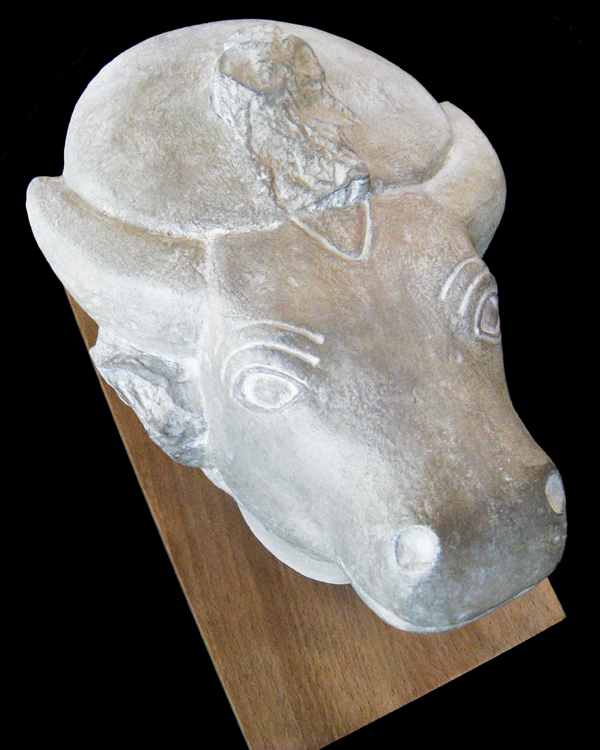
Head of an Apis Bull
Egyptian
replica: from the Staatlichen Museen, Berlin
gift of: Peter and Doris Bietenholz
date of the original: c. 600 BC
provenance of the original: Egypt, now in the Egyptian Museum, Berlin
description: Bull’s head mounted on wooden plaque. Plaster replica; stone original. Height 33 cm, width 26 cm, depth 15 cm.
Apis was a fertility bull-god whose worship began early in Egyptian history. He was also a protector of the dead and tied closely to the pharaoh (see also: Pharaoh Psammeticus II). Apis was sometimes depicted with the sun-disk of Hathor, his mother, between his horns. Apis was unique among Egyptian deities: he was represented as a bull only (although he later gained an equivalent, the syncretic Hellenistic-Egyptian god Serapis). The bull, therefore, was an extremely important sacred animal. Bull-calves born with the markings of Apis were highly revered.
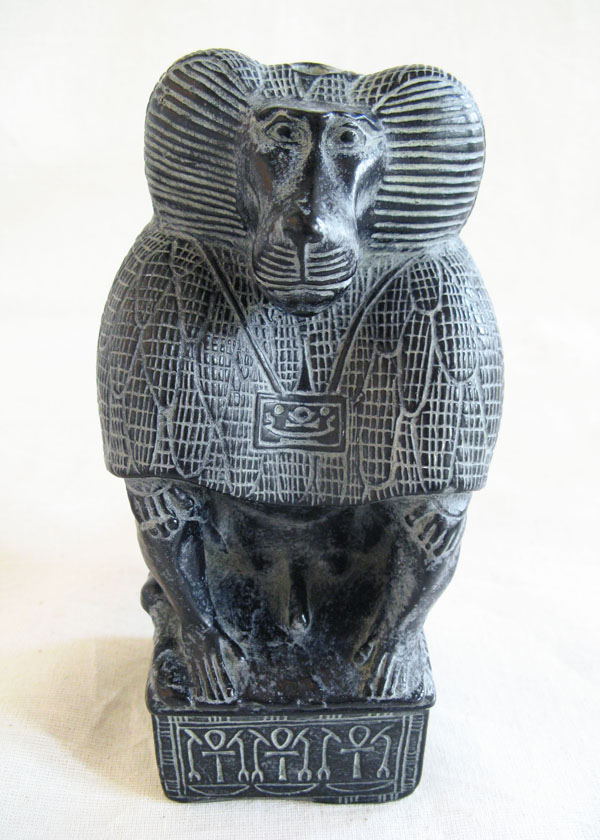
Thoth as a Baboon
Egyptian
replica: from the Staatlichen Museen, Berlin
gift of: Peter and Doris Bietenholz
date of the original: 1st century BC
provenance of the original: Egypt, now in the Egyptian Museum, Berlin
description: The god Thoth represented as a baboon. Plaster replica; serpentine original. Height 16.5 cm, width 8.5 cm, depth 8 cm
Wisdom, writing and counsel were ascribed to the god Thoth. He settled disputes between the living gods and was also connected to the souls of the dead. He was depicted most commonly with the body of a man and the head of an ibis.
When represented as a baboon, he symbolized those creatures who rose early with the sun, and was therefore held to be connected to the sun god Ra. Baboons were a feature in early Egyptian festivals (5300-3000 BC); they later became important to the Early Dynastic Kings of Horus (3000-2686 BC).
Thoth was also depicted as a lunar god or as a messenger god. He came to be associated with Hermes (see: Hermes and the Infant Dionysus) in the Ptolemaic period (332-30 BC).
(See also: Faience Amulets.)
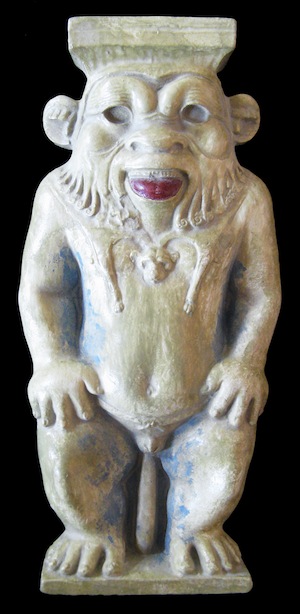
Bes
Egyptian
replica: from the Staatlichen Museen, Berlin
gift of: Peter and Doris Bietenholz
date of the original: 750-650 BC
provenance of the original: Egypt, now in the Egyptian Museum, Berlin
description: Figurine of the god Bes. Plaster replica; blue faience original. Height 16.5 cm, width 8 cm, depth 2 cm.
Protector of women and children and the sun god Ra, Bes was a household god characterized as a bandy-legged dwarf. Originally, Bes spirits wore the skins of lions on their backs. Over time, they were depicted with only lion’s ears and tails. The lion symbolism may have come from Bes’ possible Sudanese origins; the god made his appearance in Egypt in the Twelfth Dynasty (2000-1790 BC).
Bes was called upon in times of illness and used music to frighten away evil spirits. His head is often depicted over the figure of a naked child as a protective guardian. His facial expressions varied from jolly to fierce.
His image came to be a common amulet (see: Faience Amulets), which many wore around the neck. His likeness has also been found on mirrors, beds, head-rests, cosmetic pots, stelae, and altars. Bes had no temple and was dependent on individual summons.
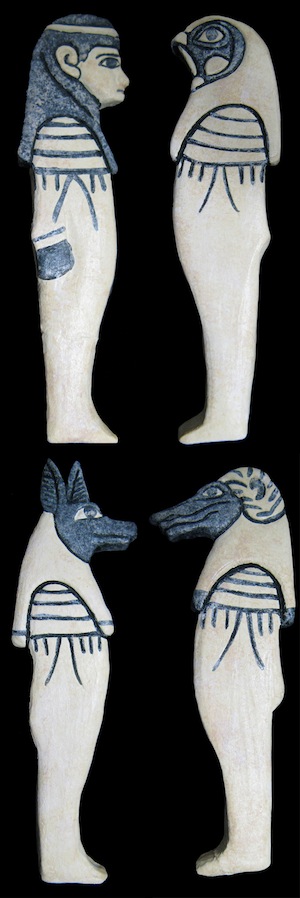
Canopic Figures
Egyptian
replicas: by artist Carrie Allen
date of the original: c. 1069 BC
provenance of the original: Egypt
description: Canopic figures representing the four sons of Horus. Replicas; wax originals. Each: height 9 cm, width 3 cm, depth .5 cm.
The Egyptians realized that the removal of the abdominal organs, and therefore much of the moisture in the human body, was crucial to the process of mummificiation. Beginning in the eleventh dynasty (2134-1991 BC), the viscera were placed in embalming fluid and housed in four canopic jars that represented the four sons of Horus, an important Egyptian deity (see: Horus as a Falcon; Horus/Sobek.)
Each jar was also associated with a tutelary goddess: the jar containing the liver with Isis, the lungs with Nephthys, the stomach with Neith, and the intestines with Selket (see: Scorpion Amulet). The jars were then entombed with the deceased. During the twenty-first dynasty (1077-943 BC) this practice changed. The organs were embalmed, packaged separately with wax figures like these replicas, and returned to the abdominal cavity.
(See also: False Door; Ushabtis.)

Egyptian "Captives"
Egyptian
replicas: by artist Carrie Allen
gift of: the Nasser Family
date of the original: 1160 BC
provenance of the original: temple of Pharaoh Rameses III, Medinet Habu; now in the Egyptian Museum, Cairo
description: Floor tiles depicting five different representatives of subjugated peoples. Plaster replicas; ivory originals. Each: height 16-18 cm, width 4-5 cm, depth 2 cm.
These five ivory reliefs are floor tiles from the temple of Pharaoh Rameses III at Medinet Habu. Each represents, through hairstyle, clothing and skin colour, one of five different tribes over which Egypt held sway. From left to right, top to bottom: Libyan, Nubian, Syrian, Bedouin, Hittite.
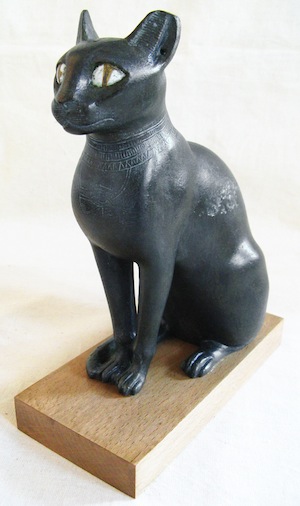
The Cat Bastet
Egyptian
replica: from the Staatlichen Museen, Berlin
gift of: Peter and Doris Bietenholz
date of the original: c. 600 BC
provenance of the original: Egypt, now in the Egyptian Museum, Berlin
description: Seated cat. Eyes painted white and gold. Inscribed ornate collar and breastpiece with the Eye of Horus. Plaster replica; bronze original. On base: height 23.5 cm, width 8.75 cm, depth 19 cm.
Bastet was the goddess of cats, fire, home and childbearing. She made her home in the city of Bubastis, which lay along the Nile’s eastern Delta. Bastet frequently adopted a feline form; originally depicted with the head of a lion, she later assumed the image of a woman with a cat’s head, or a fully cat-like form.
In the Late Egyptian Period (672-332 B.C.), the festivals of Bastet became very popular, honouring the goddess through dance, music, drink and sacrifice. Many people brought their cats, who had died, to this festival to have them embalmed and buried in sacred receptacles.
(See also: Faience Amulets.)

Face of a God or Pharaoh
Egyptian
original
gift of: the Minden Family
date: Ca. 1st c. BC
provenance: Egypt
description: Face of a figurine of a god or pharaoh.
Terracotta.
Height: 6 cm
Width: 9 cm
Fragment, overall wear and encrustation.
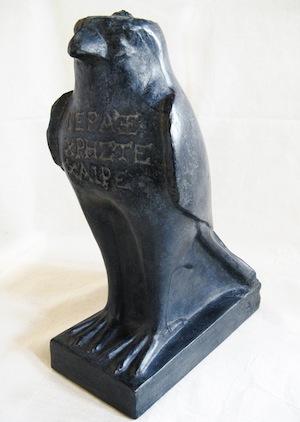
Horus as a Falcon
Egyptian
replica: from the Staatlichen Museen, Berlin
gift of: Peter and Doris Bietenholz
date of the original: Ptolemaic Period
provenance of the original: Egypt, now in the Egyptian Museum, Berlin
description: The god Horus represented as a falcon. Inscription on chest reads "IEPAΣ XPHΣTE XAIPE." Plaster replica; black stone original. Height 37 cm, width 14.5 cm, depth 27.5 cm.
Horus, the falcon deity whose name means “he who is above,” was often depicted with a sun-disk on his head. Known alternatively as the sky god and the sun god, Horus was one of Egypt’s earliest deities. He was identified with the pharaohs beginning in the dynastic period, about 3100 BC.
The Eye of Horus, or Wedjat Eye, represented healing, strength, perfection and wholeness, and was often worn as a protective amulet (see: Faience Amulets).
(See also: Horus/Sobek.)
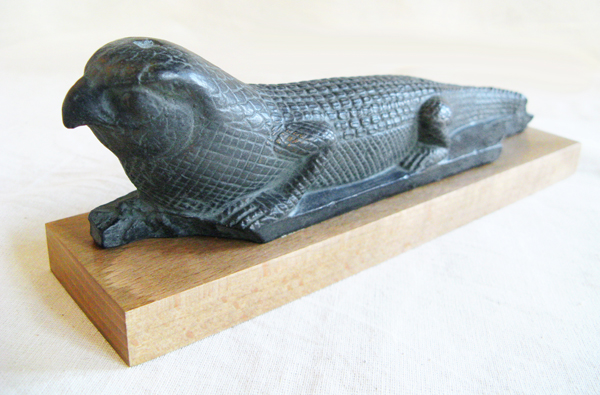
Horus/Sobek
Egyptian
replica: from the Staatlichen Museen, Berlin
gift of: Peter and Doris Bietenholz
date of the original: Late Egyptian Period
provenance of the original: Egypt, now in the Egyptian Museum, Berlin
description: Figurine of a crocodile with a falcon head, representing a union of the deities Sobek and Horus. Plaster replica; green stone original. On base: height 7.5 cm, length 21.75 cm, width 5.25 cm.
The god Horus (see also: Horus as a Falcon) unites in this figurine with the god Sobek, the deified crocodile of Egypt. Sobek represented the fertility of the Nile as well as its dangers; he eventually became a deity of the military. His ambiguous nature made him a distant and untouchable figure.

Narmer Palette
Egyptian
replica: by artist Carrie Allen
date of the original: c. 3rd millennium BC
provenance of the original: Hierakonopolis, Upper Egypt (discovered by J.P. Quibell); now in the Egyptian Museum, Cairo
description: Black double-sided palette with two-dimensional imagery. Plaster replica (two-thirds original size); schist original. Height 36.5 cm, width 21.5 cm, depth 2 cm.
The Narmer Palette is one of the earliest historical records from ancient Egypt. It records King Narmer’s victory over Lower Egypt, at which point he became the king of all Egypt. On the reverse of the palette, Narmer wears the White Crown of Upper Egypt; on the obverse, he wears the Red Crown of Lower Egypt. The king’s name appears on both sides in the serekh (one of the earliest ways of presenting the king’s name) at the top and center on the palette, flanked by images of the goddess Hathor who was likely credited with providing the king’s victory.
The obverse shows the king in smaller stature following a series of standard bearers. Behind him is an attendant carrying his sandals and a small water jar. To the right of the standard bearers are the enemies Narmer has slain with their severed heads placed between their feet. The central scene shows two beasts with intertwined necks that form a circle. This was very likely the part of the palette where cosmetics were crushed. Below is the Apis Bull (see: Head of an Apis Bull), a symbol of the king’s strength.
The reverse shows the victorious King Narmer standing very prominently in the center, brandishing a mace in his right hand, about to smite an enemy whom he clutches by the hair with his left hand. Below are images of his enemies drowning. To the right is the falcon god Horus (see: Horus as a Falcon), the protector of the king, also participating in the subduing of Narmer’s foes, perched upon papyrus plants. Papyrus was a symbol of Lower Egypt and therefore represented the king’s conquest of the region. Once again we see the sandal-bearer to the left of the king.

Pharaoh Psammeticus II
Egyptian
replica: from the Louvre, Paris
date of the original: 595-589 BC
provenance of the original: now in the Louvre, Paris
description: The Pharaoh standing with left foot forward and arms lengthened by his sides. Plaster reproduction; schist original. Height 84.5 cm, width 22.5 cm, depth 38 cm.
Pharaoh Psammeticus II was a king of the twenty-sixth Dynasty of Egypt--the last native Dynasty to rule Egypt prior to the Persian conquest. Under the command of Pharaoh Psammeticus II the Egyptians were able to throw the Kushites out of their land and re-conquer Nubia.
This statue depicts the classic Egyptian stance with left foot forward and hands clenched by the sides. On the back of the statue is inscribed the name of the Pharaoh in hieroglyphs. The piece is carved from a fine, green schist with smooth polished surfaces. The original was restored at the beginning of the 19th c. by the sculptor Laboureur.

Sphinx
Egyptian
replica: from the Staatlichen Museen, Berlin
gift of: Peter and Doris Bietenholz
date of the original: 4th-3rd century BC
provenance of the original: discovered in 1851 by August Mariette in the Sacred Way of the Serapeum at Saqqara, Memphis, Egypt; now in the Egyptian Museum, Berlin
description: Reclining sphinx. Plaster replica; limestone original. Height 69 cm, length 126 cm, width 41 cm.
This statue is a copy of one of the sphinxes that lined the Sacred Way to the Serapeum at Saqqara. The Saqqara Serapeum is a series of catacombs northwest of the Step Pyramid of Djoser. The Serapeum was the home of the cult of the Apis Bull (see: Head of an Apis Bull) and the later syncretic god Serapis and contains many massive granite sarcophagi for the bulls. The catacombs date back at least as early as the eighteenth dynasty and continued to be in use until the Ptolemaic Period. However, the sphinxes appear to be from the third or fourth centuries BC, which correspond to the Late Egyptian Period.
Symbolizing royal power, wisdom and strength, sphinxes were tomb guardians. They are, almost without exception, represented as male and with the body of a lion. For example, the great Sphinx at Giza has the body of a lion and the head of Khafre, king of Egypt from about 2258-2532 BC.
(See also: Ivory Winged Sphinx.)
Figurines & Amulets

Bronze Amulets
Egyptian
originals
gift of: W.A.S. Sarjeant
date: Late Egyptian Period
provenance: purchased by donor
description: Two bronze amulets. Amulets were worn by the Egyptians for protection and good luck, and buried with the dead to ensure safe passage to the afterlife. (See also: Faience Amulets; Scorpion Amulet; Blue Glass Amulet.)
This amulet (top) may be Nefer-Atmu, the son of Ptah and Bast (see: The Cat Bastet) , who represented the power of the rising sun. Height 7 cm, width 1 cm, depth 2 cm.
The other amulet (bottom) represents Osiris, who came to be associated with death and the grave. Pharaohs (see also: Pharaoh Psammeticus II) were considered to be embodiments of Osiris. Height 8.5 cm, width 3 cm, depth 2 cm.

Faience Amulets
Egyptian
originals
bequest of: W.A.S Sarjeant
date: Late Egyptian Period
provenance: purchased by donor
description: 94 original faience amulets of varying sizes: 12 various gods, 3 scarab seals, 6 depicting the god Bes (see: Bes), 6 depicting a kneeling Shu with upraised arms, 25 wedjats, 13 spacer beads, 11 depicting the gods Horus (see: Horus as a Falcon; Horus/Sobek), Bastet (see: The Cat Bastet) and Thoth (see: Thoth as a Baboon), 8 depicting various animals, and 10 miscellaneous items including djed pillars.
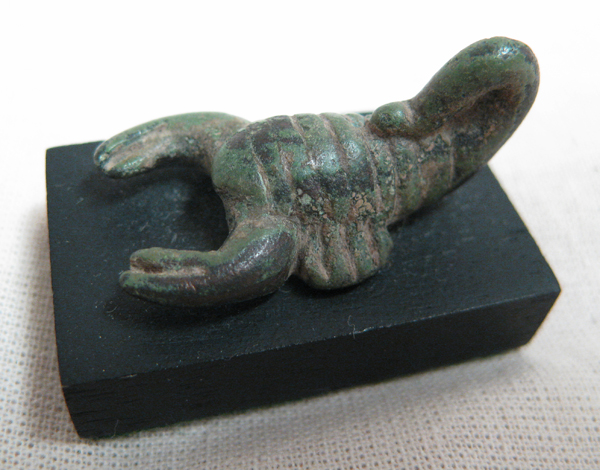
Scorpion Amulet
Egyptian
original
gift of: Professor Thurston Lacalli
date: unknown
provenance: purchased by donor
description: Verdigris bronze figure of a scorpion with its tail curved over to meet its body, creating a hole to accomodate a chain or wire. Mounted on a wooden block. Height 3 cm, length 4 cm, width 2.5 cm.
This piece may represent the Egyptian goddess Selket. She was one of the protective goddesses of the Nile and was often depicted as a woman with a scorpion head or vice versa. She guarded over Apep who, defeated by the defendors of Ra, was sent to the underworld, her domain. Her consort was the human-limbed serpent deity Nekhebkau who also inhabited the underworld.
She was most commonly described as assistant to Isis in caring for Horus (see: Horus as a Falcon) and preparing the funerary rites for Osiris (see: Bronze Amulets). She was also the tutelary deity associated with one of the canopic jars (see: Canopic Figures).
(See also: Faience Amulets; Blue Glass Amulet.)

Ushabtis
Egyptian
originals
date: see below, if known
provenance: see below, if known
description:
#1: Gift of Mr. John L. George. Date and provenance unknown. Original ushabti of green faience. Mummiform shape. Hieroglyphs inscribed on back. Height 11 cm, width 2.5 cm, depth 1 cm.
#2: Bequest of W.A.S. Sarjeant. Date: New Kingdom. Purchased by donor; was found in a child's tomb excavated in Carthage in 1944. Original ushabti of green faience. Hieroglyphics inscribed on back. Mummiform shape. Height 8 cm, width 2 cm, depth 1 cm.
#3: Bequest of W.A.S. Sarjeant. Date: New Kingdom. Purchased by donor; was found in a child's tomb excavated in Carthage in 1944. Original ushabti of green faience, now blackened. Hieroglyphs inscribed front and back. Mummiform shape. Height 14.5 cm, width 4.5 cm, depth 3 cm..
#4: Gift of Prof. Thurston Lacalli. Date and provenance unknown. Original ushabti of blue faience. Mummiform shape. Height 4 cm.
#5: Gift of the Minden Family. Date: 1st c. CE. Syro-Palestine or Egypt. Pale green faience with added brown. Height 6.2 cm, diameter 2.2 cm.
Shabtis or shawabtis were mummy-like servant figurines. In pre-dynastic times real servants were sometimes buried with their masters. By the time of the New Kingdom, people were buried with all-purpose shawabtis (meaning persea-wood figures) instead. These later came to be called ushabtis or shabtis. It was thought that in the afterlife a ushabti would come to life when called and perform the duties demanded of the dead person. Therefore, most are inscribed with the name of the dead.
(See also: Canopic Figures; False Door.)
Inscriptions
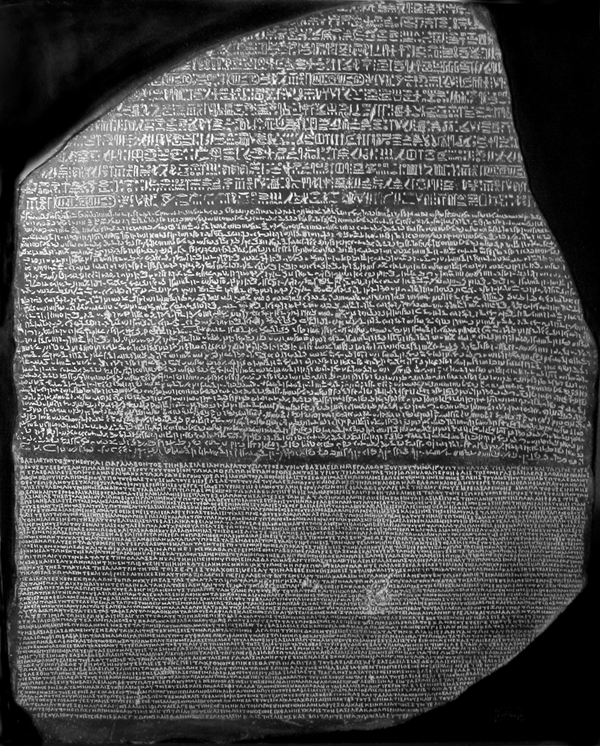
Rosetta Stone
Egyptian (Hellenistic)
replica: from the British Museum, London
date of the original: 196 BC
provenance of the original: discovered by Napoleon’s army in AD 1799 at Râshid (Rosetta) on the Nile Delta; now in the British Museum, London
description: Triligual inscription in three bands: hieroglyphic, demotic and Greek script. Black resin block replica; black basalt original. Height 96 cm, width 76 cm, depth 5.5 cm.
The Rosetta Stone is the surviving part of a great basalt monument or stele bearing an inscription dated to the 9th year (196 BC) of Ptolemy V Epiphanes (210-180 BC). The Ptolemaic rulers of Egypt, of whom Cleopatra was the last (died 30 BC), were of Macedonian origin and spoke Greek. This decree, voted by the priests of Egypt at Memphis, is repeated in two languages--Egyptian (in both hieroglyphic and demotic scripts) and Greek. It records the good deeds of Ptolemy and the honours proposed for the twelve-year-old King. Copies of the decree were to have been erected in many of the temples of Egypt.
The decipherment of the Rosetta Stone was begun by the French scholar Champollion in 1816. Through the Rosetta Stone and other similar bilingual inscriptions, scholars were at last able to translate the hieroglyphs of ancient Egypt.
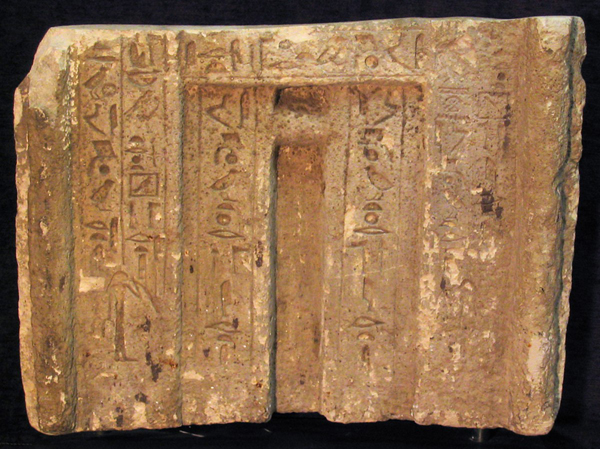
False Door from the Tomb of a Priestess of Hathor, Irti
Egyptian
original
gift of: Dr. Robert McCorkell
date: c. 2200 BC (Old Kingdom, 6th Dynasty)
provenance: Egypt
description: Original limestone relief: lower portion of a false door with hieroglyphic inscription. Height 48.5 cm, width 65.5 cm, depth 12 cm.
Made for the the tomb of a priestess named Irti of the goddess Hathor. The so-called “false doors” are a common feature of Egyptian tombs of the Old and Middle Kingdoms (2780-2280 and 2134-1778 BC, respectively). The Egyptians believed that the afterlife was similar to the life of the living. (See also: Ushabtis; Canopic Figures.) For this reason, the dead too required food for sustenance. Offerings were supplied by the descendants of the deceased or by mortuary priests. It is believed that the primary function of false doors like this one was to offer the soul of the deceased access to this world in order to receive such offerings. They are called false doors because they do not open.
There are a total of five inscriptions on this false door: the horizontal text on the lintel, two columns on the inner jambs, and four columns on the outer jambs, two on each side.
The horizontal text on the lintel and two columns on the inner jambs reads “The revered one before the great god, Irti.”
The right side jamb in two columns reads 1) “…for the revered one, Irti,” and 2) “…One connected to the royal cult, the Priestess of Hathor Irti.”
The left side jamb in two columns reads 1) “…[revered one before?] the great god and lord of the West, One connected to the royal cult, the Priestess of Hathor Irti;” and 2) “…[revered before Osiris, lord of Bu]siris, the revered one Irti.”
On the two outermost columns are two images of a human, holding a lotus and standing facing the central niche, as if about to enter the doorway.
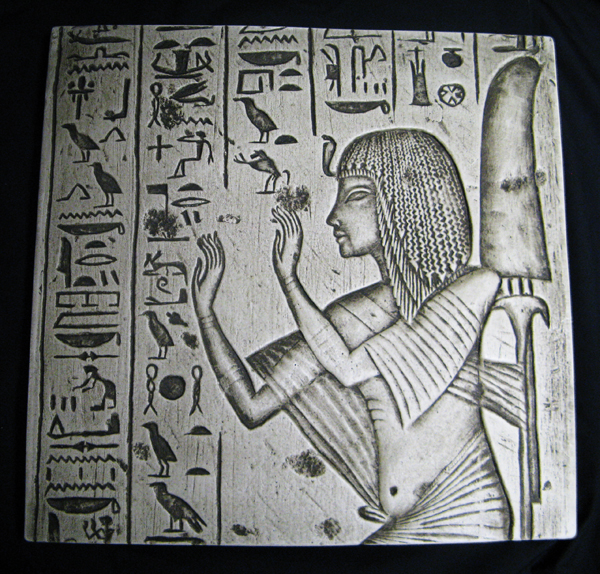
Fragment from the Tomb of Horemheb
Egyptian
replica: from Design Master Facsimiles
gift of: the Colistro Family, dedicated in memory of Ronald Freaker
date of the original: c. 1350 BC
provenance of the original: the tomb Chapel of Horemheb, Egypt; now in the Egyptian Museum, Cairo
description: Fragment from a stele. Plaster reproduction; limestone original. Height 32.5 cm, width 32.5 cm, depth 2 cm.
Horemheb was a modest scribe who emerged as a military leader under Amenhotep III. General Horemheb then advanced to the highest levels of government, first under the Pharoah Akhenaten (see:Amarna Tablet), then under Tutankhamun, and finally serving as Prime Minister under Pharaoh Ay. With the death of Ay, Horemheb became Pharaoh of Egypt.
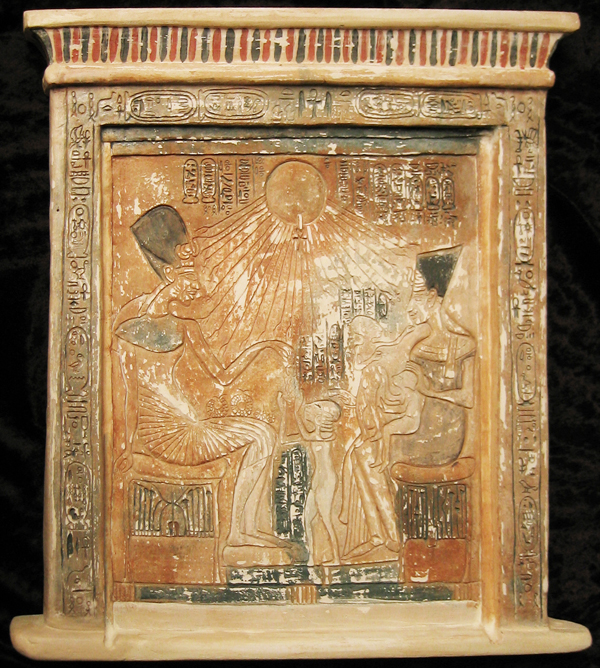
Amarna Tablet
Egyptian
replica: by artist Carrie Allen
date of the original: 1352-1336 BC
provenance of the original: now in the Egyptian Museum, Cairo
description: Painted plaque depicting the Pharaoh’s family. Plaster replica. Height 36 cm, width 35.5 cm, depth 3.5 cm.
This New Kingdom tablet depicts royal piety to the sun god, Aten. It is from Pharaoh Akhenaten’s reign and shows Akhenaten and his wife Nefertiti with two of their daughters. It is a rare depiction of affection between the Pharaoh and his family.
During his reign, Akhenaten imposed many changes on the normally static Egyptian artistic tradition (see: Pharaoh Psammeticus II; Narmer Palette): the elongation of heads, hands and bodies, as the figures on this tablet display, was one such change.